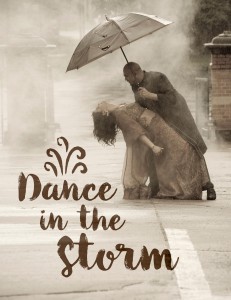Dance in all its many forms is an empowering way to move through stress, pain, grief, depression and physical discomfort—especially in hurricane season.
In Florida, Hurricane Irma is once again a major topic of discussion now that “storm season” is upon us. I hear questions such as: How did you survive? Were you okay? What were the damages? What was the length of time you were without power and internet? So many people were affected by Irma as it landed on the heels of Harvey (which caused severe floods, damage and the loss many lives in the Houston area). Irma is now considered one of the most devastating and intense hurricanes in recorded history; at 650 miles wide, it moved through the Caribbean as a Category 5 storm, made landfall on the barrier islands of Southwest Florida near Ft. Meyers, and carved a path straight up the center of Florida. According to a breakdown by Architectural Digest online, at one point, “…it sustained winds of 185 m.p.h. for 37 hours, left millions without power, and destroyed one out of every four homes in parts of Florida.” (https://www.architecturaldigest.com/story/breaking-down-hurricane-irma-by-the-numbers)
As a resident of Southwest Florida, I felt the blow hard, but I also recognized that the hurricane symbolized a new beginning. Storms are Mother Nature’s way of cleansing the Earth—her way of releasing emotional energy and clearing the way for a new beginning. But, at the same time, these events are life threatening and impact our everyday activities in a powerful way. People are forced to stop, look, listen and be present within and without during the NOW. As individuals step back from their normal patterns habits, devices and routines, they may see and interpret themselves and their life in new ways. When life is threatened, human beings automatically respond and act differently. Survival instincts kickstart the human brain and put us into fight-or-flight mode.
Hurricanes spark mental images of an overwhelming and traumatic survival crisis, which causes tremendous physical, mental and emotional stress; the amount depends on how an individual appraises or perceives the situation. The storms trigger worries over the possibility of living without power, food, water, gasoline, shelter, and even cable and internet. Hurricanes also can mean the loss of a home, possessions and even death. Last year, people in Florida, Texas, Puerto Rico and the Virgin Islands experienced an incredible amount of stress and Post-Traumatic Stress Disorder (PTSD) elicited by Harvey and Irma.
Symptoms of PTSD include reexperiencing a traumatic event through nightmares and flashbacks, emotional numbness, isolation, inability to relate socially, increased vulnerability, and elevated anxiety, anger and guilt. Some of the ways to cope and heal from stress and PTSD are to connect with a social group or friends, talk and share with others, seek counseling, practice self-care, exercise, journal writing and—my favorite—dancing.
I have found 27 studies on the effectiveness of dance movement therapy that all concluded dancing should be recommended as part of treatment for people with depression and anxiety.
Dancing provides physical, psychological and social benefits. It can enhance your mood and has been shown to reduce depression, anxiety and stress and boost self-esteem, body image, coping ability and overall sense of well-being—with the benefits lasting over time. In one study, it even helped to control “emotional eating” in obese women who use food as a response to stress.
Although many forms of exercise can have similar benefits, dancing is more appealing to some people because they are more likely to stick with it. At the end of one study that compared tango dancing to mindfulness meditation, 97 percent of participants chose to receive a voucher for a tango class rather than one for mindfulness meditation. (By the way, the study found that both activities reduced depression, but only dancing reduced stress levels.) In another study, researchers said that attendance was higher with waltzing than conventional exercise, possibly because “dance is a form of exercise in which movement, social interaction, and fun are mixed together.”
I have danced through my fears, anxiety, anger, grief, sorrows, stress and pain. I have danced in happiness and joy. Regardless of the motivation behind the movement, stillness always results when the body opens and the heart awakens to new awareness, knowing and seeing.
Are you ready to put your dancing shoes, move through hurricane season, and find peace in the eye of the storm?
Arielle Giordano’s new book, Dancing with Your Story from the Inside Out, was released in March 2017. With a Masters of Arts and Masters of Education, Arielle is an author, professional dancer, inspirational speaker, certified Essentrics/Aging Backwards instructor, and workshop facilitator. She enjoys sharing her gifts and talents with an authentic style rich in the grace of dance, psychology, philosophy and the expressive arts. Her career includes:provisional psychologist, guidance counselor and substance-abuse therapist. As a Lead Faculty Area Chair person and Faculty Member for College of Humanities at the University of Phoenix, she inspired students with her creative gifts. She also writes for Tampa Bay Wellness, We Woman and Transformation Magazine.

